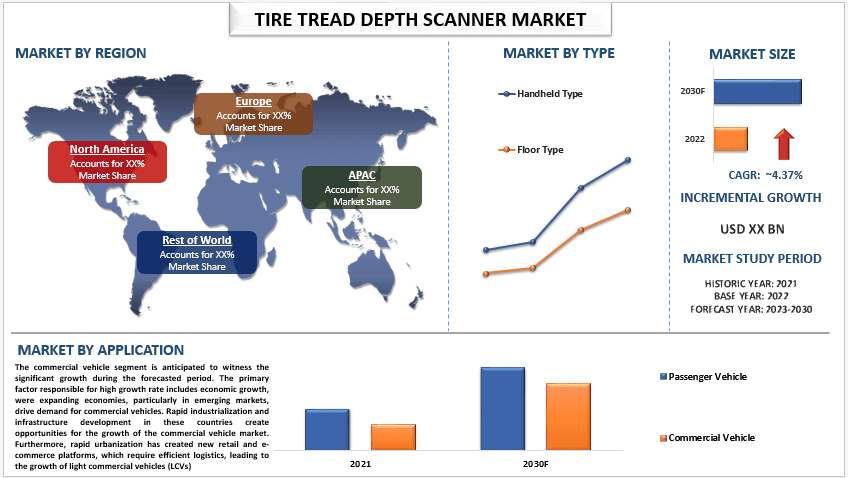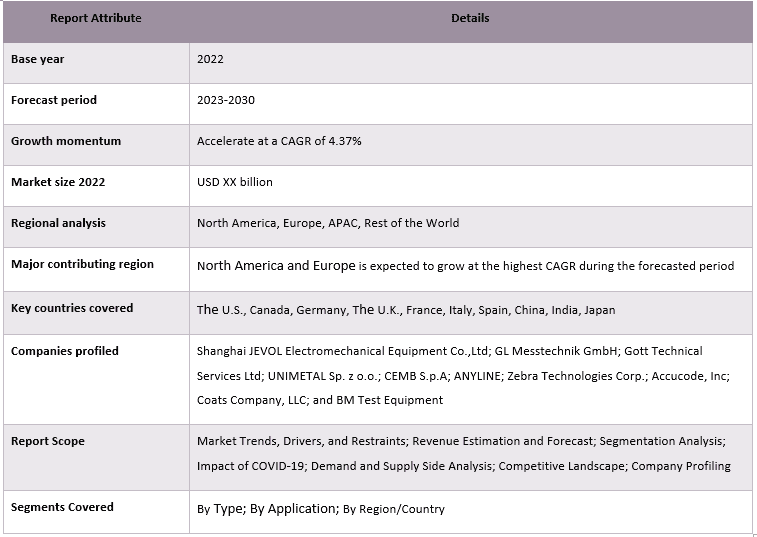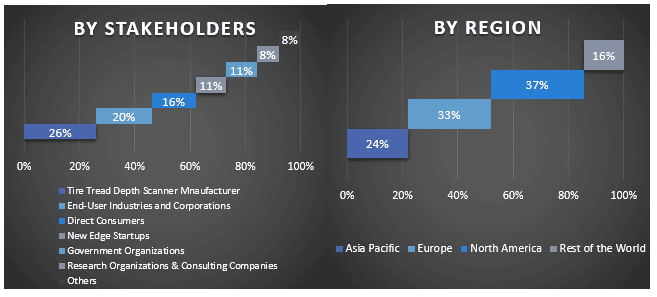- Home
- About Us
- Industry
- Services
- Reading
- Contact Us
Tire Tread Depth Scanner Market: Current Analysis and Forecast (2023-2030)
Emphasis on Type (Handheld Type and Floor Type), Application (Passenger Vehicle and Commercial Vehicle); and Region/Country

The Tire Tread Depth Scanner Market was valued at billion in the year 2022 and is expected to grow at a steady rate of around 4.37% during the forecast period (2023-2030), owing to the rapid technological change undergoing in the automotive industry. The automotive industry is experiencing significant advancements in technology, such as the development of electric vehicles and the increasing use of digital technology in vehicle maintenance. This rapid growth and technological change create a demand for advanced tire tread depth scanners to keep up with the evolving industry. Furthermore, as vehicles age and wear out, there is a growing need for tire maintenance and replacement. Tire tread depth scanners can help drivers and tire dealers monitor the wear and tear of their tires, ensuring timely replacement and maintaining road safety. Moreover, the development of innovative tire tread scanning technology is further fueling the growth of this industry. For instance, Companies like Anyline and TreadReader are developing innovative tire tread scanning technologies, such as mobile apps and handheld devices, that make it easier for tire dealers and drivers to measure tire tread depth and analyze tire wear. These advancements in technology are driving the growth of the tire tread depth scanner market.
Some of the major players operating in the market include Shanghai JEVOL Electromechanical Equipment Co.,Ltd; GL Messtechnik GmbH; Gott Technical Services Ltd; UNIMETAL Sp. z o.o.; CEMB S.p.A; ANYLINE; Zebra Technologies Corp.; Accucode, Inc; Coats Company, LLC; and BM Test Equipment. Several M&As along with partnerships have been undertaken by these players to facilitate customers with hi-tech and innovative products/technologies.
Insights Presented in the Report
“Amongst type, the handheld segment held the significant share of the market in 2022.”
Based on type, the market is bifurcated into handheld type and floor type. The handheld type of tire tread depth scanner holds most of the market share and is growing at the fastest rate. The factors responsible for this high market share and growth rate include convenience, where handheld scanners are compact and easy to use, making them more accessible to users in various settings, such as garages, dealerships, and roadside assistance. Furthermore, handheld tire tread depth scanners, like the TreadReader, provide consistent and precise measurements across the entire tire circumference, ensuring accurate results. Additionally, handheld scanners can be used in various industries, including automotive, transportation, and fleet management, making them versatile and adaptable to different market needs.
“Amongst applications, the commercial vehicle segment is anticipated to grow at a significant CAGR during the forecast period (2023-2030).”
Based on application, the market is bifurcated into passenger vehicles and commercial vehicles. The commercial vehicle market is anticipated to witness significant growth during the forecasted period. The primary factor responsible for the high growth rate includes economic growth, were expanding economies, particularly in emerging markets, drive demand for commercial vehicles. Rapid industrialization and infrastructure development in these countries create opportunities for the growth of the commercial vehicle market. Furthermore, rapid urbanization has created new retail and e-commerce platforms, which require efficient logistics, leading to the growth of light commercial vehicles (LCVs). Moreover, governments are investing significantly in initiatives like power generation, road construction, mining, and mega and smart cities, all of which are expected to fuel the commercial vehicle market. With this ever-expanding market of commercial vehicles, the tire tread depth scanner will also witness a significant surge in demand for the tire maintenance of commercial vehicles to ensure safe operations, hence is expected to grow at an impressive CAGR during the forecast period.
“North America and Europe to lead the growth in the tire tread depth scanner segment during the forecasted period (2022-2030).”
North America and Europe hold most of the market share. The primary factor responsible for this domination are in Europe, the tire tread depth scanner market is driven by the region’s stringent safety regulations. The European Union has implemented strict safety regulations for vehicles, which require the use of tire tread depth scanners to ensure that tires are safe for use. This has led to an increase in the demand for tire tread depth scanners in the region. Whereas in North America, the tire tread depth scanner market is driven by the region’s large automotive industry. The region is home to some of the world’s largest automotive markets, such as the United States and Canada. The automotive industry in these countries is growing rapidly, with increasing demand for vehicles and related products and services. This has led to an increase in the demand for tire tread depth scanners in the region
Tire Tread Depth Scanner Market Report Coverage

Reasons to buy this report:
- The study includes market sizing and forecasting analysis validated by authenticated key industry experts.
- The report presents a quick review of overall industry performance at one glance.
- The report covers an in-depth analysis of prominent industry peers with a primary focus on key business financials, product portfolios, expansion strategies, and recent developments.
- Detailed examination of drivers, restraints, key trends, and opportunities prevailing in the industry.
- The study comprehensively covers the market across different segments.
- Deep dive regional level analysis of the industry.
Customization Options:
The global tire tread depth scanner market can further be customized as per the requirement or any other market segment. Besides this, UMI understands that you may have your own business needs, hence feel free to contact us to get a report that completely suits your requirements.
Table of Content
Research Methodology for the Tire Tread Depth Scanner Market Analysis (2023-2030)
Analyzing the historical market, estimating the current market, and forecasting the future market of the global tire tread depth scanner market were the three major steps undertaken to create and analyze the adoption of tire tread depth scanner in major regions globally. Exhaustive secondary research was conducted to collect the historical market numbers and estimate the current market size. Secondly, to validate these insights, numerous findings and assumptions were taken into consideration. Moreover, exhaustive primary interviews were also conducted, with industry experts across the value chain of the global tire tread depth scanner market. Post assumption and validation of market numbers through primary interviews, we employed a top-down/bottom-up approach to forecasting the complete market size. Thereafter, market breakdown and data triangulation methods were adopted to estimate and analyze the market size of segments and sub-segments of the industry pertains to. Detailed methodology is explained below:
Analysis of Historical Market Size
Step 1: In-Depth Study of Secondary Sources:
A detailed secondary study was conducted to obtain the historical market size of the tire tread depth scanner market through company internal sources such as annual reports & financial statements, performance presentations, press releases, etc., and external sources including journals, news & articles, government publications, competitor publications, sector reports, third-party database, and other credible publications.
Step 2: Market Segmentation:
After obtaining the historical market size of the tire tread depth scanner market, we conducted a detailed secondary analysis to gather historical market insights and share for different segments & sub-segments for major regions. Major segments are included in the report as type and application. Further country-level analyses were conducted to evaluate the overall adoption of testing models in that region.
Step 3: Factor Analysis:
After acquiring the historical market size of different segments and sub-segments, we conducted a detailed factor analysis to estimate the current market size of the Tire Tread Depth Scanner market. Further, we conducted factor analysis using dependent and independent variables such as type and application of the tire tread depth scanner market. A thorough analysis was conducted for demand and supply-side scenarios considering top partnerships, mergers and acquisitions, business expansion, and product launches in the tire tread depth scanner market sector across the globe.
Current Market Size Estimate & Forecast
Current Market Sizing: Based on actionable insights from the above 3 steps, we arrived at the current market size, key players in the global Tire Tread Depth Scanner market, and market shares of the segments. All the required percentage shares split, and market breakdowns were determined using the above-mentioned secondary approach and were verified through primary interviews.
Estimation & Forecasting: For market estimation and forecast, weights were assigned to different factors including drivers & trends, restraints, and opportunities available for the stakeholders. After analyzing these factors, relevant forecasting techniques i.e., the top-down/bottom-up approach were applied to arrive at the market forecast for 2030 for different segments and sub-segments across the major markets globally. The research methodology adopted to estimate the market size encompasses:
- The industry’s market size, in terms of revenue (USD) and the adoption rate of the tire tread depth scanner market across the major markets domestically
- All percentage shares, splits, and breakdowns of market segments and sub-segments
- Key players in the global tire tread depth scanner market in terms of products offered. Also, the growth strategies adopted by these players to compete in the fast-growing market.
Market Size and Share Validation
Primary Research: In-depth interviews were conducted with the Key Opinion Leaders (KOLs) including Top Level Executives (CXO/VPs, Sales Head, Marketing Head, Operational Head, Regional Head, Country Head, etc.) across major regions. Primary research findings were then summarized, and statistical analysis was performed to prove the stated hypothesis. Inputs from primary research were consolidated with secondary findings, hence turning information into actionable insights.
Split of Primary Participants in Different Regions

Market Engineering
The data triangulation technique was employed to complete the overall market estimation and to arrive at precise statistical numbers for each segment and sub-segment of the global tire tread depth scanner market. data was split into several segments & sub-segments post studying various parameters and trends in the areas of the type and application in the global tire tread depth scanner market.
The main objective of the Global Tire Tread Depth Scanner Market Study
The current & future market trends of the global tire tread depth scanner market were pinpointed in the study. Investors can gain strategic insights to base their discretion for investments on the qualitative and quantitative analysis performed in the study. Current and future market trends determined the overall attractiveness of the market at a regional level, providing a platform for the industrial participant to exploit the untapped market to benefit from a first-mover advantage. Other quantitative goals of the studies include:
- Analyze the current and forecast market size of the tire tread depth scanner market in terms of value (USD). Also, analyze the current and forecast market size of different segments and sub-segments.
- Segments in the study include areas of type and application.
- Define and analyze the regulatory framework for the tire tread depth scanner
- Analyze the value chain involved with the presence of various intermediaries, along with analyzing customer and competitor behaviors of the industry
- Analyze the current and forecast market size of the tire tread depth scanner market for the major region
- Major countries of regions studied in the report include Asia Pacific, Europe, North America, and the Rest of the World
- Company profiles of the tire tread depth scanner market and the growth strategies adopted by the market players to sustain in the fast-growing market
- Deep dive regional level analysis of the industry
Frequently Asked Questions FAQs
Q1: What is the current market size and growth potential of the global Tire Tread Depth Scanner market?
Q2: What are the driving factors for the growth of the global Tire Tread Depth Scanner Market?
Q3: Which segment has the largest share of the global Tire Tread Depth Scanner market by Type?
Q4: What are the emerging technologies and trends in the global Tire Tread Depth Scanner market?
Q5: Which region will dominate the global Tire Tread Depth Scanner market?
Q6: Who are the key players operating in the global Tire Tread Depth Scanner market?
Related Reports
Customers who bought this item also bought










